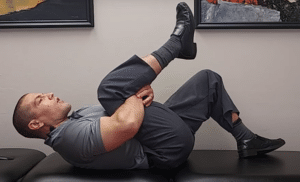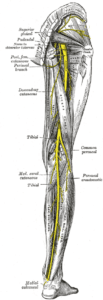Do You Get Shooting Pain In Your Legs?
Watch this video to learn 5 common causes shooting pain in the legs plus exercises and other tips to relieve shooting pain in the legs.

5 Causes of Shooting Pain in Legs
Here are some of the most common causes of shooting pain in the legs. This list isn't all-inclusive, but it will at least give you a list of issues to discuss with your healthcare provider.
1. Hip Arthritis
When many people have shooting leg pain, they'll describe it to their doctor as pain radiating from their hip down their leg.
Often that will lead to a hip x-ray.
However, if you're over 50, like many of my patients, it's very likely that you may have some hip arthritis on your x-ray.
However, even if you have arthritis on your x-ray, it may or may not be the cause of your pain.
Hip arthritis can cause shooting pain down the leg, but when it does, it often causes pain down the front or inside of the thigh.
It's more common though to have shooting pain down the back or outside of the leg.
That's why it's crucial to be accurate and specific with the location of your symptoms when describing them to your doctor.
Doing so will help you get a more accurate diagnosis.
If you experience shooting pain down the front or inside of your leg due to hip arthritis, check out my video on the 5 best exercises for hip arthritis.
However, hip arthritis isn't the most common cause of shooting pain down the leg.
2. Pinched Nerve in Lower Back
The most common cause of shooting pain down the leg is a pinched nerve in your lower back.
Depending on the level of the pinched nerve, it can cause pain down the front, side, or back of your leg.
The L2, L3, and L4 nerve roots can cause shooting pain down the front of your leg.
The L5 nerve root can send a shooting pain down the side or your leg.
Finally, the S1 and S2 nerve roots can cause shooting pain down the back of your leg.
How to relieve shooting pain in legs from a pinched nerve
If you're over 50 or have degenerative disc disease or spinal stenosis, extension positions or backward bending movements of your spine are more likely to pinch the nerves.
Conversely, doing forward bending movements can help relieve shooting pain.
This may include exercises like:
Child's pose
Kneel on your hands and knees and rock back your hips back toward your heels. Hold this position for about 1 minute or as needed to relieve symptoms.
Single knee to chest
Lie on your back and pull one knee up to your chest as far as you can. It helps to have the other knee bent up as well. This flattens out your lower back. Hold for 1 minute or as needed to relieve symptoms.
Standing forward bending
Traditionally, it has been thought that standing forward bending isn't good for your lower back. It is true that many people get lower back pain when bending forward.
However, if you forward bend properly, it can also be helpful. You should use a combination of both pushing your hips back and allowing your spine to bend forwards. You should also allow your lower back muscles to relax when forward bending.
This position does put your sciatic nerve on tension, so if you get shooting pain in your leg when doing this exercise, skip it and opt for seated forward bending instead.
Seated forward bending
Sit in a chair bend forward bringing your chest toward your knees. Allow your lower back muscles to relax. Hold for 1 minute or as needed to relieve symptoms.
Each of these exercises can be done as needed to relieve shooting pain in your legs.
Pain relief should happen fairly quickly, and these exercises SHOULD NOT be painful.
If they are, stop doing them and seek out help from a professional.
3. Peripheral Nerve Compression
Another cause of shooting pain down your leg can be peripheral nerve compression.
The sciatic nerve can cause shooting pain down the back of your leg.
However, the femoral nerve down the front can also be affected.
Sciatic nerve problems may cause pain in your buttock when sitting too long. This is especially true if you're siting on hard surfaces.
Either a stiff or lengthened piriformis can also irritate the sciatic nerve.
Exercises for shooting pain in leg from sciatic nerve
Doing a piriformis stretch can help if you have a shortened piriformis.
However, if the muscle is lengthened and weak, hip strengthening exercises may be more helpful.
These can include exercises such as clamshells.
Additionally, doing sciatic nerve glides may be helpful as your nerves need movement and blood flow to be healthy.
Tips for shooting pain in legs from femoral nerve compression
Femoral nerve compression is much less common than sciatic nerve compression.
However, removing sources of compression such as tight belts is a good idea.
Additionally, stretching your hip flexors can help.
To do the kneel hip flexor stretch shown above, kneel on the leg that you're going to stretch with the other knee up. Push your pelvis forward until you feel a stretch in the front of the hip and thigh. Hold for about 1 minute per leg.
If you can't kneel, check out this post to learn 4 different hip flexor stretches.
Finally, doing femoral nerve glides can help relieve shooting pain.
Lie face down and bend one knee up as shown only as far as you can comfortably. Return to the starting position and repeat for 10-20 repetitions.
4. Muscular Pain
Muscular pain, particularly from the gluteus medius and minimus muscles can cause shooting pain down the outside of the leg to the knee or even into the lower leg.
Referred pain from these muscles is often misdiagnosed as piriformis syndrome, hip bursitis, or an L5 nerve root compression.
That's because these muscles have a similar referral pattern as the L5 nerve root.
The gluteus medius and gluteus minimus muscles often become painful when their tendon is stretched over the outer side of the hip bone. This may start out as outer hip pain when walking or climbing stairs.
This is often due to hip weakness.
Therefore, practicing balancing on one leg can be helpful to strengthen these muscles.
Offloading these muscles by walking with a cane or rollator walker may be necessary in the short-term in order to relieve the pain. However, the long term goal is to get the muscles stronger so that you can walk pain-free without needing an assistive device.
5. Systemic Causes
Systemic causes, like diabetic neuropathy or peripheral artery disease, may result in shooting leg pain.
Typically, systemic causes will affect both legs equally and usually the smaller blood vessels and nerves in the lower leg and foot.
This is often described as a "stocking" pattern of symptoms.
Pain in the legs from peripheral artery disease is usually worsened with physical exertion and relieved with rest.
General lifestyle changes such as eating a healthy diet low in sugar and saturated fat and getting regular aerobic exercise can be helpful.
However, both of these conditions should be managed by a healthcare professional.
In fact, any shooting pain the legs should be managed by a healthcare professional.
Regardless of the cause, the longer the condition goes on untreaded (or improperly treated) the worse it can get.
In the case of nerve compression, the longer nerves are compressed, the greater the chance of lasting nerve damage.
So if things have gotten bad enough that you're experiencing shooting pain in the legs, it's time to get help.
Seeing an expert can help you figure out the problem quickly and get started on the proper treatment.
Need Help For Shooting Pain In Your Legs?
If you live in the St. Louis area and you need help for shooting pain in your legs, we'd be happy to help you here at More 4 Life.
Just tap the button below to request an appointment with one of our specialist physical therapists.
Like this post? Here are some other posts you may enjoy
What Causes Pain In Thigh Muscle?
Unable To Lift Leg When Lying Down? Here's Why (plus what to do)
Numbness In Legs: Causes and Treatment
5 Causes Of Numbness In ToesHow To Treat Numbness In The Toes

















